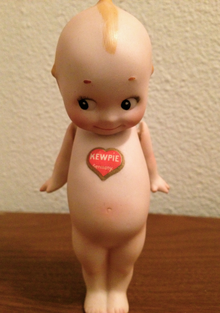Kewpie doll (toy)

Original German-made bisque Kewpie, circa 1912
|
|
| Type | Doll, figurine |
|---|---|
| Inventor | Rose O'Neill |
| Company |
|
| Country | United States |
| Availability | 1912–present |
| Materials | Bisque, composition, celluloid, rubber, plastic |
Kewpie is a brand of dolls and figurines that were conceived as comic strip characters by cartoonist Rose O'Neill. The illustrated cartoons, appearing as baby cupid characters, began to gain popularity after the publication of O'Neill's comic strips in 1909, and O'Neill began to illustrate and sell paper doll versions of the Kewpies. The characters were first produced as bisque dolls in Waltershausen, Germany, beginning in 1912, and became extremely popular in the early 20th century.
The Kewpie dolls were initially made out of bisque exclusively, but composition versions were introduced in the 1920s, and celluloid versions were manufactured in the following decades. In 1949, Effanbee created the first hard plastic versions of the dolls, and soft rubber and vinyl versions were produced by Cameo Co. and Jesco between the 1960s and 1990s.
The earlier bisque and composition versions of Kewpie dolls are widely sought-after by antique and doll collectors, who especially want those hand-signed by O'Neill. Kewpies should not be confused with the baby-like Billiken figures that debuted in 1908.
Rose O'Neill, a Midwest native who had worked as a writer and illustrator in New York City, initially conceptualized the Kewpie as a cartoon intended for a comic strip in 1909. According to O'Neill, the idea for the Kewpies came to her in a dream. The comic, featuring the cherub-faced characters, was first printed in Ladies' Home Journal in the December 1909 issue. O'Neill described the characters as "a sort of little round fairy whose one idea is to teach people to be merry and kind at the same time." Their name, often shortened to Kewpies, derives from Cupid, the Roman god of erotic love. After the characters gained popularity among both adults and children, O'Neill began illustrating paper dolls of them, called Kewpie Kutouts.
As demand for the Kewpie characters increased, Geo. Borgfeldt & Co. in New York contacted O'Neill in 1912 about developing a line of dolls and figurines. O'Neill agreed, and J.D. Kestner, a German toy company located in Waltershausen, set forth to manufacture small bisque dolls of the Kewpies. After the company manufactured the first run of dolls, they sent samples to O'Neill, who disapproved of the design because she felt they "did not look like her characters."
...
Wikipedia
